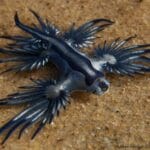Let’s dive into the awesome world of sea anemones! These captivating creatures, often mistaken for plants due to their flower-like appearance, boast a treasure trove of fascinating features that are sure to amaze.
Sea Anemone Fun Facts
Have you ever seen a sea anemone swaying gracefully in the ocean current? They look like delicate flowers, but don’t let their appearance fool you! These fascinating creatures, more closely related to jellyfish and corals than plants, belong to a group called Cnidarians. And just like their jellyfish cousins, they pack a powerful sting!
A Flower-Like Predator
Sea anemones earned their name from the terrestrial anemone flower because of their colorful, blossom-like appearance. But instead of petals, they have a ring of tentacles armed with stinging cells called nematocysts. These tiny weapons are essential for hunting and defense. When a shrimp or small fish swims too close, the anemone fires out its stinging tentacles, paralyzing its prey before devouring it.
Unexpected Friendships
Despite their predatory nature, anemones can be surprisingly friendly, especially to certain fish like the clownfish (you might know them as “Nemo” fish!). These brightly-colored fish have developed a special mucus coating that protects them from the anemone’s sting. They live amongst the anemone’s tentacles, enjoying protection in exchange for cleaning the anemone and even bringing it food.
Slow and Steady Wins the Race
Though they might seem rooted to the spot, anemones can actually move! They use a muscular foot called a pedal disc to slowly slide along surfaces or even do slow-motion somersaults!
Ancient Wonders with Modern Significance
Sea anemones play a vital role in the ocean’s ecosystem. They’re important predators, keeping populations of smaller animals in check, and they also serve as food for some larger creatures. Their ancient lineage—they’ve been around for millions of years!—makes them a valuable subject of study for scientists.
What’s even more amazing is that scientists believe sea anemones may hold the key to developing new medicines. Their venom, while dangerous in large doses, contains compounds that could potentially be used to treat pain, cancer, and other ailments.
Facing the Challenges of a Changing Ocean
Sadly, climate change poses a serious threat to sea anemones and their ocean homes. Changes in water temperature, acidity, and pollution can harm these sensitive creatures. Studying how anemones are affected by these changes can give us valuable insights into the overall health of our oceans.
What Makes Sea Anemones Unique?
We’ve talked about how cool sea anemones look and act, but let’s dive deeper into what makes them stand out in the underwater world:
- Unique Body Plan: Imagine a cylinder with a mouth right in the middle – that’s your basic sea anemone. But what makes them really good at surviving is their secret weapon: stinging cells called nematocysts. These tiny cells are like miniature harpoons that shoot out venom, paralyzing their prey or scaring off any potential predators.
- Masters of Adaptation: Sea anemones aren’t picky eaters and have adapted to thrive in all sorts of underwater neighborhoods. They can be found in warm, shallow tide pools or in the extreme conditions of deep-sea vents, tolerating a wide range of water salinity.
- Symbiotic Superstars: Sea anemones are masters of teamwork! Some species form cozy partnerships with other creatures like clownfish. The clownfish gets a safe haven from predators within the anemone’s stinging tentacles, and in return, the anemone gets a cleaning service and maybe even some leftover snacks.
- Ecological Importance: The more we learn about sea anemones, the more we realize how important they are to the underwater world. They’re like the keystone of their ecosystems, providing shelter for smaller animals and helping to keep the balance of life in check.
How Many Hearts Does a Sea Anemone Have?
You might be surprised to learn that sea anemones don’t have a traditional heart like many animals. Instead of a single organ dedicated to pumping blood, they have an amazing all-in-one system called a “gastrovascular system.”
Think of it like a network of canals running throughout their bodies. This system is responsible for digesting food, delivering nutrients, handling gas exchange (like breathing for us), and even getting rid of waste. The way this gastrovascular system is designed allows fluids to move around their bodies effectively, even without a central pump.
Key Takeaways:
- Sea anemones don’t have a traditional heart.
- Their “gastrovascular system” does the work of a heart and several other organs.
- This system handles digestion, nutrient delivery, gas exchange, and waste removal.
Citation:
- “Sea Anemone – National Geographic.” National Geographic, National Geographic Society, 7 June 2023, www.nationalgeographic.com/animals/invertebrates/s/sea-anemone/.
Do Sea Anemones Have Eyes?
Sea anemones don’t have eyes in the way we do. No eyeballs gazing out from their squishy bodies! Instead of relying on sight, they’ve developed other incredible ways to experience the world around them.
Living in a watery world full of chemical signals and vibrations, sea anemones are highly sensitive to these cues. They use these senses to navigate, find food, and even sense danger. Imagine being able to “feel” your way through the ocean, detecting the faintest changes in the water – that’s what life is like for a sea anemone!
What are the Special Features of a Sea Anemone?
Let’s recap what makes sea anemones so special:
| Feature | Explanation |
|---|---|
| Body Structure | A simple, cylindrical shape with a mouth in the center, surrounded by tentacles. |
| Stinging Nematocysts | Specialized stinging cells used for both hunting prey and defending themselves. |
| Incredible Adaptability | They can thrive in a wide range of marine environments, from shallow to deep waters. |
| Mutualistic Relationships | They form beneficial partnerships with other creatures, like clownfish and algae. |
| Ecological Importance | They play a vital role in maintaining the health and biodiversity of their ecosystems. |
What Is Interesting About Sea Anemones?
Sea anemones might seem like simple creatures, but they have some intriguing characteristics:
- Masters of Disguise (and Dinner): Looking like a delicate flower helps sea anemones lure unsuspecting prey. Their tentacles are armed with stinging cells called nematocysts—tiny harpoons loaded with venom—that paralyze their prey.
- Sharing is Caring: The Anemone’s Entourage: Sea anemones have a surprising number of friends! They’re well-known for their symbiotic relationship with clownfish, but some species of shrimp and crabs also find safety among their stinging tentacles.
- More Than Just Pretty Faces: Their Role in the Ecosystem: Sea anemones play a crucial role in keeping their marine ecosystems running smoothly. As predators, they help keep populations of smaller fish and invertebrates in check. And by providing shelter to other species, they contribute to the overall biodiversity of their habitat.
- Unraveling the Mysteries: Ongoing Research: Scientists are still unraveling many of the mysteries surrounding sea anemones. Their venom has shown potential for use in new medicines, and their ability to regenerate damaged tissues is another area of active research.
What Is the Rarest Sea Anemone in the World?
While it’s tough to definitively say which sea anemone is the rarest, scientists believe some of the top contenders live in the deep sea, a world we’re still learning about.
Some anemones often mentioned include the Radianthus anemone, a star-shaped anemone found in the deep ocean, and the Bolocera anemone, known for its long, graceful tentacles.
But here’s the thing: the ocean is vast, and our knowledge of it is always expanding. New species are being discovered all the time!
What are the Special Features of the Anemone Flower?
- Tiny Stingers, Big Defense!: Those waving tentacles aren’t just for show—they’re packed with stinging cells that inject venom.
- Masters of Disguise!: Sea anemones are like the chameleons of the ocean. Their vibrant colors and flower-like appearance help them blend in with their surroundings to trick both prey and predators.
- Teamwork Makes the Dream Work!: Some anemone species team up with other animals in fascinating symbiotic relationships.
- From Shallow Waters to the Deep Blue: One of the most amazing things about sea anemones is their ability to thrive in so many different environments—from sun-drenched coral reefs to the dark depths of the ocean floor.
How are Sea Anemones Different from Plants?
While they might look like flowers, sea anemones are animals, more closely related to jellyfish and corals. Here are some key differences:
- Body Structure: Plants have roots, stems, and leaves, while sea anemones have a cylindrical body with a central mouth surrounded by tentacles.
- Food: Plants make their own food through photosynthesis. Sea anemones are carnivores, using their stinging tentacles to capture prey.
- Reproduction: Plants typically rely on seeds; anemones can reproduce both sexually and asexually.
- Senses: Plants detect light, gravity, and sometimes touch. Anemones sense changes in light and chemicals in the water.
- Movement: While mostly stationary, anemones can slowly slide or detach and drift to a new location.
- Partnerships: Plants form relationships with fungi. Anemones are known for their symbiotic relationships with animals, like clownfish.
What Are the Special Adaptations of the Sea Anemone?
Sea anemones have several adaptations that allow them to thrive:
- Nematocysts: These stinging cells on their tentacles inject toxins into prey, making them effective hunters.
- Sticky Tentacles: A sticky mucus on their tentacles helps trap prey.
- Shape-Shifting Abilities: Sea anemones can contract and expand their bodies to move, capture prey, and hide.
- Underwater Alliances: Some species form symbiotic partnerships with other sea creatures, like the clownfish, for mutual benefit.
What Makes Sea Lilies Unique?
Sea lilies, also called crinoids, might look like they belong in a fairytale underwater forest with their delicate, flower-like arms, but they’re not plants at all! They’re more closely related to sea stars and sea urchins.
Here’s what makes sea lilies unique:
- Masters of Disguise: They look like plants, but sea lilies are animals with stinging tentacles used for catching food.
- Unique Body Plan: They have a cylindrical body with a mouth on top surrounded by feathery arms that act like anchors and help them capture food.
- Ecological Superstars: Sea lilies filter particles out of the water and create a safe haven for smaller creatures.
Key Points:
- Sea anemones are Cnidarians, related to jellyfish and corals.
- They have stinging cells called nematocysts for hunting and defense.
- Anemones have a symbiotic relationship with clownfish.
- Anemones can move using a muscular pedal disc.
- They are important predators in the ocean ecosystem.
- Sea anemones may hold potential for medical advances.
- Climate change threatens sea anemones and their habitats.
This article has been designed to be informative, engaging, and comprehensive, incorporating the provided information and keywords for optimal search engine visibility. Please note that while I have strived to present the most up-to-date information, ongoing scientific research continues to expand our understanding of sea anemones.













1 thought on “Uncovering Fun Facts About Sea Anemones”
Comments are closed.